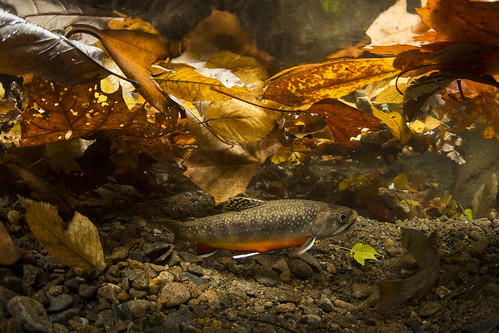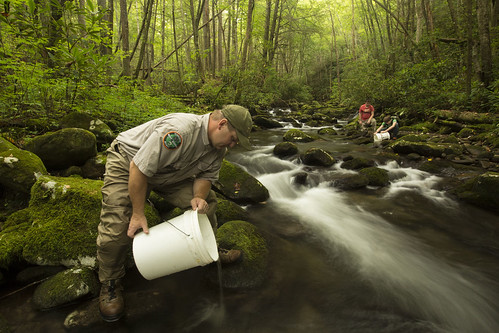
For a community of brook trout in the southern Appalachian mountains, there are signs that the good times are coming back. To some, these native inhabitants might even appear to be waving a welcome home sign.
Their numbers almost vanquished, they are as much a cultural emblem of these rugged and lush mountain forests as they are an important signal for the highest quality drinking water. This is what makes their fate of such interest to the millions who live in the surrounding watersheds and to those involved in an inspiring partnership to help them along. They are also the subject of a new film, “Bringing Back the Brooks: Reviving the South’s Trout” produced by Freshwaters Illustrated in partnership with the U.S. Forest Service.
“The brook trout was native to not only the small headwater streams, but also to these larger rivers. We like to call it the jewel of the southern Appalachians,” said Jim Herrig, a fisheries biologist on the Cherokee National Forest who provides the historical perspective. “Unfortunately, because of activities that occurred back in the early 1900's - devastation logging, road building and fire - the brook trout was almost eliminated from the southern Appalachians.”
They inhabited the clean mountain streams and rivers of southern Appalachia for more than two million years. But as unregulated industrial forestry altered water quality and water temperatures, the brook trout nearly disappeared in just a handful of decades.
The Weeks Act passed by Congress in 1911 authorized the purchase of millions of acres of denuded mountainsides in the eastern United States. These ‘lands that nobody wanted’ were allowed to regrow into our beloved eastern national forests. As water quality began to slowly recover, rainbow trout from the western states were stocked into the streams because they were readily available from local fish hatcheries at the time. In most mountain streams across the South, rainbow trout still dominate the now clear, cold waters.
Those involved in the partnership recognized that this native fish was an important piece of the region’s rich biodiversity and an important part of the rich culture of these ancient mountains. Their goal is to claim that role well into the future.
Only recently have biologists unlocked the key to reproducing the finicky southern Appalachian brook trout in fish hatcheries. Because their remaining populations are very small and isolated in remote headwaters streams often less than a mile in length, this effort to restock and supplement existing populations is giving a much needed boost to the South’s native trout.

Travis Scott, a fish biologist with the Tennessee Wildlife Resources Agency, adds important context to environmental recovery of these mountain streams.
“Most of these lands here that would be the home to brook trout are protected by the Forest Service. When they came in and started protecting this land and working to preserve what forest they could and regrow what forest had been cut … once you started doing that, the land can start recovering,” said Scott. “We've gotten back to these pristine, clean, beautiful waters. These are the headwaters for a lot of people's drinking water. If these streams are clean enough to support the brook trout, then that's a good indication that it's starting out as clean as it can be.”
The sounds of recovery include the voices of those involved, their activities and the splashes, scurries and breezes that mark the seasons. Horses clop along the trail, a mountain stream rushes among dense thickets of rhododendron, and a wood thrush trills in the tall trees above as they mix with the laughter and excited conversation of people below. These sights and sounds belong to dedicated volunteers from the Southern Appalachian Back Country Horsemen, fisheries biologists from the state of Tennessee and the Cherokee National Forest, volunteers from Trout Unlimited and local boy scouts who are hiking deep into a hollow along a headwater stream. They are united in their effort to return the southern Appalachian brook trout to the fresh and clean waters of the Cherokee.
“They are absolutely gorgeous fish, all these beautiful colors - the reds and greens and yellows and browns and golds,” adds Scott. “Fall is the perfect time of year, because their underbelly matches the foliage. It's bright orange with these white and black tips on their fins. They are such a striking fish and in this environment it's hard to beat.”
The film is part of a series that explores aquatic conservation and biodiversity in Appalachian waters and national forests including an innovative river conservation program and snorkeling experience on the Cherokee and a dramatic view of how the eastern hellbender, North America’s largest salamander, is battling for survival. All three films are part of the U.S. Forest Service NatureWatch program and will be part of a March 24 screening at USDA’s Jefferson Auditorium in Washington D.C. as part of the D.C. Environmental Film Festival.
Reservations are highly encouraged. Email kawinter@fs.fed.us and in the subject line include “RSVP” and your full name. Please arrive at least 30 minutes early to allow for security screening. Photo ID required. Use the entrance to the U.S. Department of Agriculture South Building located in Wing 4, half way down the block from the Smithsonian Metro exit on 1400 Independence Avenue, SW.

